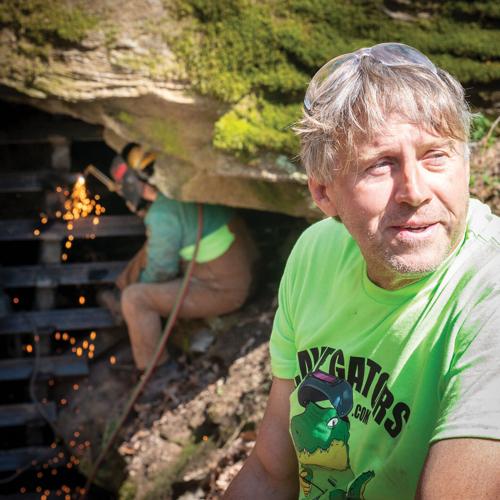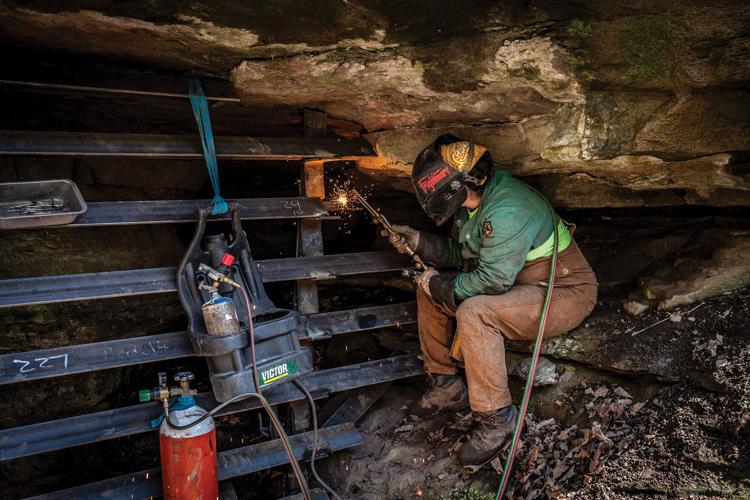
Crash Kennedy
Jim “Crash” Kennedy stands on a forested path, hands on his hips, looking down into a sinkhole at a massive cave entrance perhaps 20 feet tall and 15 feet wide.
“We clearly have a little waterfall,” he says to his assistant, welder/fabricator Lydia Hernandez. He walks down a slope toward the void and points overhead to small cubby holes in the limestone.
“We have these upper-level paths,” he says. “I don’t know if they connect or not. But just to keep the idiots from climbing into those, we have to put the gate outside, which means it has to be attached about right there, where the wetness meets the dryness.”
Hernandez nods in agreement.
The scene looks like a tropical jungle in an adventure movie but is actually a wilderness area within a Nashville city park. Crash Kennedy, based in Austin, Texas, may have one of the most unusual jobs in America: building bat-friendly, vandal-proof cave gates. He and Hernadez travel the country installing gates for private and public cave owners who find him through conservation groups or his website, cavegators.com. Their Nashville stop began a five-gate installation blitz through Tennessee.
Aided by local volunteers, the two spent five days building a steel gate at the request of the park’s director, who asked that neither the cave name nor the park be identified in this article to prevent more of the kind of “pervasive vandalism” the site has already endured.
As Kennedy explains, the location was in an easily accessible urban area getting increased traffic and therefore abuse. “The park wants to use the cave for educational programs, but when the cave looks like crap, programs are less effective.”

Lydia Hernandez welds a bat cave gate in Middle Tennessee
Before Kennedy, the gating team arrived. The director found volunteers to clean out graffiti, trash and broken bottles from the cave, which holds large chambers, two bat species and other wildlife. For the actual gating, stout volunteers hauled steel beams and grates up a hiking path and then down to the sinkhole. Cables snaked 20 feet below a large generator, enabling Hernadez to weld bars that would allow bats to freely pass while thwarting even the most determined (or drunken) teenager.
Kennedy earned his nickname in 1987 while working as a Pennsylvania wildlife technician, counting endangered bats in a mine that intersected with a natural cave. While he counted a last patch of bats near the top of a complex dome, a boulder shifted and carried Kennedy with it into the pit below, breaking his pelvis. During the lengthy rescue that followed, he spent hours in a stretcher, dangling in air while cavers rigged a complicated pulley system to get him safely out. “Yeah, you crashed,” said one rescuer. The next Kennedy knew, they were all calling him Crash.
Crash moved to Texas in 1995, spending 18 years as the cave specialist for Bat Conservation International. Through the conservation work, he began learning the highly specialized art of building gates to protect caves without harming cave life or altering the airflow through entrances, which could affect both biology and mineral formations.
By the end of that first day in Nashville, a basic frame for the large gate had taken shape. Four days later, the gate was done. Crash and Hernandez headed to West Tennessee the next day to start a gate to protect archaeological treasures. On the road, Crash posted a photo on Facebook of a running showerhead, with a can of Murphy’s Stout on the soap dish.
His caption: “Few things are finer in life than a shower beer after a long, hard day of work.”
He’s out there now, building one gate at a time.
Looking at the do’s and don’ts of recycling, restoring Tennessee’s waterways, protecting our caves and more




